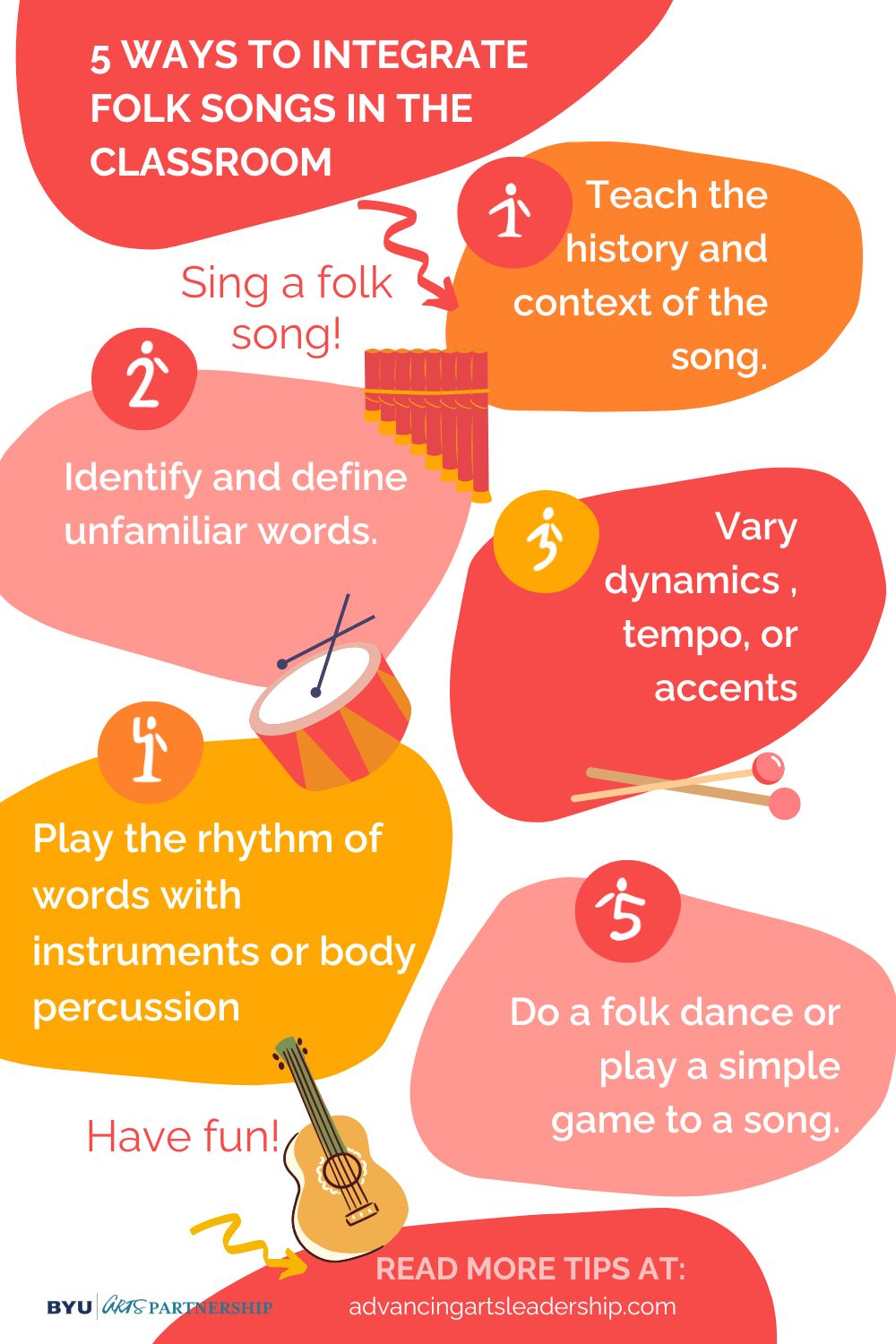What Can I Do With a Folk Song?

Folk songs tell stories and often rhyme, making them easy to learn and remember. They are also an easy way to incorporate music into your classrooms. Using folk songs can help create a culturally responsive classroom since nearly every culture offers folk songs that share pieces of history and tradition. Learn how folk songs can support your teaching, integrate the arts into your classroom to deepen student learning and have fun!
Strategies for Integrating Folk Songs in Your Classroom
Connect
- Teach the history and context of the song.
- Describe the culture or background from which the song originates.
- Research and find other variations of the same song.
- Create new verses or change the words to support a specific curriculum concept or connection.
- Compare and contrast two different songs.
Vocabulary
- Identify and define unfamiliar words.
- Review pronunciation of difficult words.
Lyrics
- Songs are literature. Use the same strategies and identify the same concepts you would use when teaching language arts and reading.
- Teach or create hand signs, movements, or gestures to represent the lyrics.
- Use ASL signs while singing.
- Identify the main idea(s) of the song.
- Determine the sequence or pattern of the lyrics.
- Identify rhyming words and rhyming patterns.
- Play instruments only on certain words or phrases of the song, using the rhythm of those words.
Duration
- Play steady beat (with non-pitched instruments or body percussion).
- Students choose one of two different instruments or body percussion. One group plays on the strong beat, the other plays the weak beat(s).
- Play the rhythm of words (with non-pitched instruments or body percussion).
- Half the students play the steady beat, while the other half plays the rhythm of the words using non-pitched instruments or body percussion.
- Identify and notate simple rhythm patterns from the song. Play as an ostinato using non-pitched percussion during the song or as an interlude.
- Students create their own simple 4- or 8-beat rhythm patterns and notate them. Play them with non-pitched percussion instruments as an ostinato throughout the song or during an interlude.
- Play a game called "Same or Different" with the children. On a wood block, drum or rhythm sticks play a rhythm pattern from the song. Then play another pattern from the song of the same length. The second pattern can be either identical to or different than the first pattern. Ask the students to listen and then show you by a designated body signal whether the pattern was the same or different the second time.
- Practice singing and playing tricky rhythms.
- Add a beat-based hand game, clapping game, or body percussion sequence.
Melody
- Use shapes, lines, and letters to explore melodic contour and play with the voice.
- Listen for the shape of the melody. Does it go up, down, or stay the same?
- Listen for skips or steps. Practice tricky intervals.
- Consider the range of the melody and ensure it is appropriate for the students' developmental abilities.
- Sing with a partner.
- Add a vocal ostinato.
- Add simple vocal harmonies.
Expressive Qualities
- Choose/use/vary dynamics (loudness or softness).
- Choose/ use/vary tempo (rate of speed).
- Choose/use/vary articulation (legato, staccato, accents).
- Shape phrases through dynamics and breathing.
- Identify the feeling of the song and respond to the emotion or mood of the piece.
Form
- Identify the form of parts or sections of the song (phrases, refrain, verses, interlude, etc.).
- Some songs allow students to create a new form or pattern of a song using symbols, pictures, or icons.
Movement
- Students follow body position cards or "follow the leader" to a beat while a song is played for the first time.
- Create and perform movements that reflect the lyrics of the song.
- Do a folk dance or play a simple game to a song.
- Pantomime (act out) a song that tells a story or create a tableau that shows a freeze-frame scene from the song.
Accompaniment
- For pentatonic songs, accompany with a melodic ostinato using notes from the pentatonic scale.
- Play an accompaniment based on simple chords (autoharp, ukulele, Orff instruments, bells, boomwhackers).
Evaluate and Refine
Students experiment with different vocal and instrumental groupings and expressive qualities as they create their accompaniment patterns. Have them listen and give meaningful feedback as their preferences. Have them focus on what they heard that brought them to their conclusion. Encourage them to apply aural discrimination (listening) throughout the arrangement process to make sure they have arrived at the very best arrangement possible for their musical taste.






